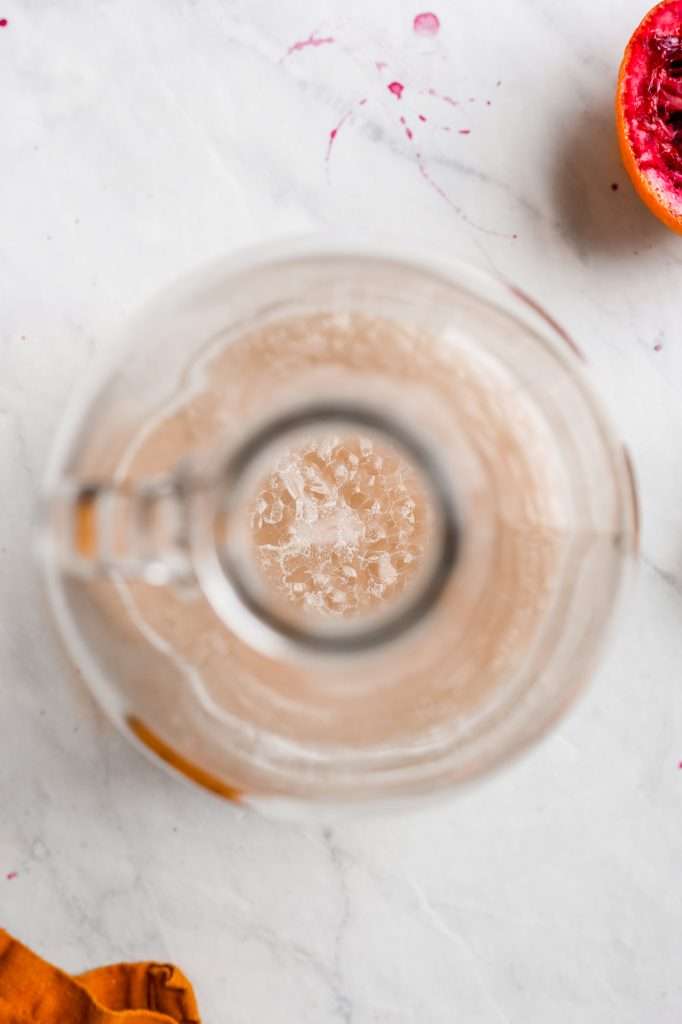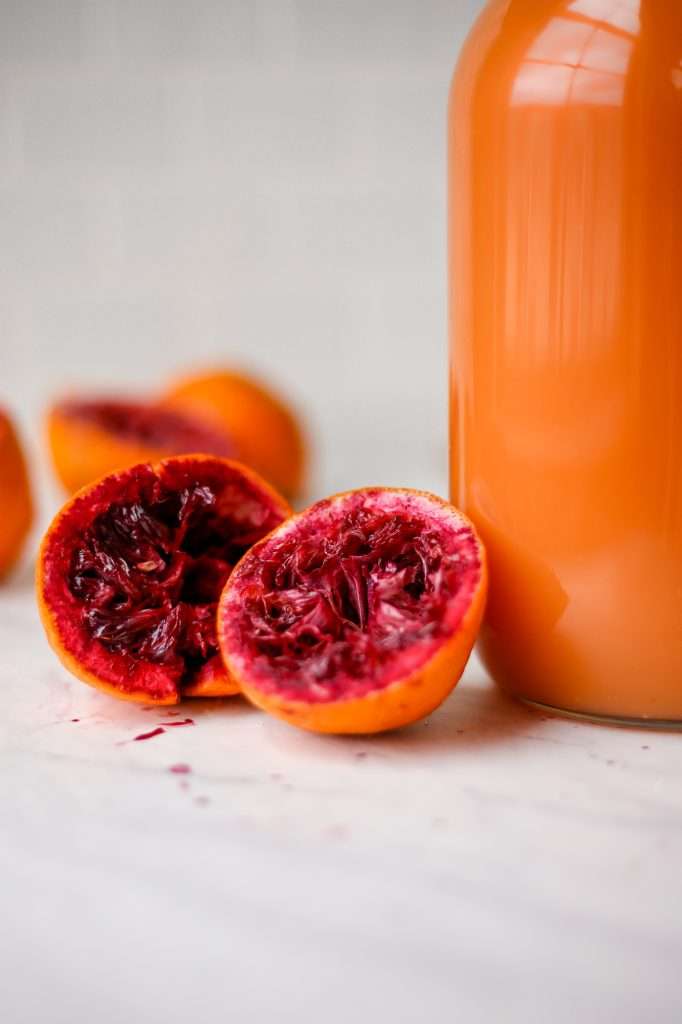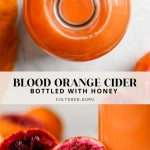Hard Blood Orange Cider
Note: Hard blood orange cider recipe results in a beverage with a significant amount of alcohol. If any readers here want a non-alcoholic version of this recipe, please try our Carrot Blood Orange Kombucha instead.
For a drink to be considered cider, it must contain at least 35% apple juice. I learned this while researching things for this blog. Well, my orange cider recipe includes only about 25% apple juice, and I’m still calling it cider. So, get over it now, homebrewers.
Cider must also be less than 8.5% ABV; otherwise, it is considered wine. This blood orange cider sits somewhere about 6-7% ABV.
My cider recipe’s high orange juice content produces exciting flavors reminiscent of some lambic sour beers. The high orange juice content also means more pectins in the cider and, thus, cloudiness in the final product. The hazy nature of orange cider is natural and no big deal.
I used a mix of organic orange juice, blood orange juice, and apple juice for this delicious cider. I bought the orange and apple juice bottled and pasteurized and juiced the blood oranges myself.

How to Make Hard Cider with Fruit Juice
If this is your first time making cider at home, I highly suggest starting with this half-gallon recipe. This lets you get acquainted with the process and taste test before committing to a large batch.
Here is my Amazon list for brewing supplies. If you have a local home brew store, that is also an option to get what you need.
I got all my supplies at my local homebrew store up the street from my house. At a homebrew store, you can have someone help you pick out the right supplies.
- 1/2 gallon glass jug (with a cap)
- a second 1/2 gallon glass jug (with cap)
- 1 rubber stopper for brewing – You will need to make sure it is the right size for your jug. Some jugs have different diameter openings. I’ve linked the size stopper that fits my 1/2 gallon glass jug.
- an S airlock for the stopper
- a funnel
- large pot for boiling
- cheap vodka (for cleaning equipment)
- Two 1-Liter swing-top bottles (carbonation safe, for bottling the cider)

Hard Blood Orange Cider Made with Orange and Apple Juice
I think brewing at home intimidates many people, so I made this recipe as easy as possible.
With this recipe, you can just buy some organic orange and apple juice at the store. I used the 365 brand of organic pressed apple juice and orange juice from Whole Foods. Both juices must be 100% fruit juice and free from any preservatives and additives. Also, make sure the juice does not have any added sugar.
For the blood orange juice, you will need to juice fresh blood oranges. I have yet to find bottled blood orange juice at the store.
I used a mix of plain orange juice with a bit of blood orange juice for this recipe to keep the cost low. You adjust the recipe to use all blood orange juice or all plain orange juice.
Here are the ingredients you’ll need:
- 2 Grams Cider Yeast (Saccharomyces bayanus)
- Organic Pasteurized Apple Juice
- Organic Orange Juice
- The Juice of about 5 blood oranges (8 fl ounces)
- Filtered Water
- Organic Cane Sugar

Choosing Yeast for Blood Orange Cider
You can use champagne yeast or cider yeast for this recipe. If you visit a home-brew store, they should be able to help you select a cider yeast.
When buying packaged yeast, I like to make sure that the yeast species is not genetically modified. We chose to use Saccharomyces bayanus. This yeast species is associated with the natural fermentation of grapes, and it’s great for any fruit cider fermentation.
Another option is to use wild yeast. You only need about two tablespoons of wild yeast starter in place of the yeast in the recipe. Click here to learn how to make a wild yeast starter.

How to Bottle and Store Cider
Bottling and storing the cider is pretty straightforward. You need to verify that you have carbonation-safe bottles.
This is a sparkling hard cider, so we are going to carbonate it. To carbonate hard cider in the bottle, we have to add a small amount of sugar, called priming sugar, right before bottling. I like to use honey as priming sugar because it contains a lot of fermentable fructans. More fructans = more bubbles.
The yeast will feed on the freshly added sugar and produce more carbon dioxide. Since the cider is in carbonation-safe bottles with the cap secure, the CO2 is forced into the cider and becomes carbonated. Bottling 1 liter with only one tablespoon of honey is not enough sugar to excessively carbonate. It’s just enough to produce a pleasant level of carbonation.
To make this a still cider instead of sparkling cider, do not add any honey or sugar when you bottle it.
You’ll need:
- Two 1-Liter Swing top bottles(Carbonation Safe)
- Organic Honey
How to Bottle
- Clean and sterilize the bottles.
- Add one tablespoon of honey to each 1 Liter bottle.
- Using a funnel, transfer the cider from the aging jug into the carbonation-safe bale top bottles, leaving the sediment in the bottom of the jug.
- Cap the bottles and invert gently twice to mix the honey with the cider.
- Allow to ferment at room temperature for five to seven days, then immediately place in the fridge. You can age the cider for 3 more weeks in the fridge before enjoying it chilled.
More Recipes to Try
- How to Make Sparkling Hard Apple Cider from Apple Juice
- Vinegar from Scratch
- How to Make Moroccan Preserved Lemons with Sea Salt
- Hard Strawberry Cider Recipe Fermented With Fresh Berries


Hard Blood Orange Cider Bottled with Honey
A delicious hazy and tart hard orange cider made with sweet orange juice and blood orange juice. This recipe includes directions for bottling the cider with honey to create a sparkling blood orange cider.
- Prep: 30 minutes
- Cook: 15 minutes
- Total Time: 1008 hours 45 minutes
Ingredients
- 32 fl oz organic orange juice
- 8 fl oz organic blood orange juice
- 16 fl oz apple juice
- 8 fl oz filtered water
- 75 grams organic sugar
- 2 grams cider yeast
Instructions
- Note: This recipe results in a beverage with a significant amount of alcohol. If any readers here want a non-alcoholic version of this recipe, please try our Carrot Blood Orange Kombucha instead.
- Clean and sanitize all of your equipment. I like to wash the jug with soap and water, allow it to air dry a bit, then rinse the jug with cheap vodka, and allow it to fully air dry.
- Once your equipment is prepped, add 1 cup of boiling water to the 1/2 gallon jug.
- Add the sugar to the jug and swirl it around to dissolve. Allow it to cool to room temperature.
- Add in the cider yeast and mix gently by swirling. Wait about 30 minutes for the yeast to get frothy and active.
- In the meantime, heat the orange, apple, and blood orange juice until simmering. Remove from heat and allow to cool to room temperature.
- Carefully using a funnel, add the juice mix to the jug leaving two inches of headspace (see pictures above).
- Cap the jug and swirl it around for about a minute.
- Remove the cap and place the airlock and stopper in the jug (see pictures above).
- After a few hours, you should notice a lot of bubbling in the cider and activity in the airlock.
- Allow the cider to ferment for 7 to 14 days until the bubbling completely stops, and you no longer see any activity in the airlock. At this point, you should see a lot of sediment in the bottom of the jug.
- Racking the cider: Remove the airlock and, using a funnel, transfer the cider to a new, clean jug for aging. Be careful pouring; pour gently and in one stead pour, leaving the sediment in the bottom of the original jug.*
- Cap the jug with a regular lid. Allow the cider to age at a cool room temperature or in the fridge for four weeks.
- After aging, you can rack the cider again with more aging time or move on to bottling.
- To Bottle the cider with honey: Clean and sterilize two 1-liter carbonation-safe bottles. Add one tablespoon of honey to each 1 Liter bottle. Using a funnel, transfer the cider from the aging jug into the carbonation-safe bottles, leaving any sediment in the bottom of the jug. Cap the bottles and invert gently twice to mix the honey with the cider.
- Allow to ferment in the bottles at a cool room temperature for five days, then immediately store in the fridge. (check the carbonation by carefully opening a bottle over the sink, if it is not carbonated enough you can leave it at room temperature for a few more days and check the carbonation again.)
- You can age the cider for 3 more weeks in the bottles in the fridge before enjoying it chilled. Keep refrigerated.
Notes
- You can use wild yeast in this recipe. You only need about two tablespoons of wild yeast starter in place of the packaged yeast in the recipe. Click here to learn how to make a wild yeast starter.
- be sure to open the bottles to release the pressure occasionally when storing in the fridge for long periods. Don’t worry, though; Bottling 1 liter with only one tablespoon of honey is not enough sugar to excessively carbonate. It’s just enough to produce a pleasant level of carbonation.




















If you have the fresh organic fruit! Can you juice oranges and apples to use in this?
I’m very interested in making this. How long would a batch keep after being bottled?
It keeps for a long while in the fridge. Gets better as it ages in the fridge too. The longest I’ve kept a bottle is 8 months (drank it all, never spoiled)
Easy to follow recipe and great tasting cider!
I only have 1 gallon fermenting jugs. Would it be possible to use those instead of the 1/2 gallon? Or would I have to double the recipe?
If using a gallon jug you should double the recipe.